|
23rd and 12th STREET INTERSECTION
This famous spot in the neighbourhood of El Vedado, near the Colón Cemetery, has been declared a National Monument.
Precisely in the intersection of these streets, is where the memorable farewell ceremony took place of the victims of the aerial attack by airplanes from the United States against several Cuban airports and facilities on April 16th of 1961. This attack was a prelude to the mercenary invasion of Playa Girón.
Fidel Castro, who spoke at the act, proclaimed the socialist character of the Cuban Revolution and in that instant thousands of militia men raised their rifles as an expression of the people’s support and as a demonstration of their will to fight in defence of socialism.
For more information:
www.cuba-havanacity.com
,
www.cuba-giron.com
,
www.cuba-history.com
,
www.cuba-fidel.com
|
|
|
AMERICAS HOUSE (CASA DE LAS AMERICAS)
 One of the institutions of prestige, it is located in the intersection of G and 3rd Avenues in the neighbourhood of Vedado in Havana City. It was opened in 1959 by Haydee Santamaría, one of the two women that took part in the attack on the Moncada Garrison (Cuartel Moncada) on July 26th of 1953.
The present day House is presided over by Roberto Fernández Retamar and due to the incessant effort of many people, here the work of writers, painters, musicians, playwrights, and scholars of literature and the arts, is made public, researched and awarded.
The building features the characteristics of a temple, and it acts like one, for over four decades it has been a refuge of the best literature, art and music of Latin America and the Caribbean. Its prestigious House Award (Premio Casa) bathed in the limelight many of today’s most successful writers in the area.
One of the institutions of prestige, it is located in the intersection of G and 3rd Avenues in the neighbourhood of Vedado in Havana City. It was opened in 1959 by Haydee Santamaría, one of the two women that took part in the attack on the Moncada Garrison (Cuartel Moncada) on July 26th of 1953.
The present day House is presided over by Roberto Fernández Retamar and due to the incessant effort of many people, here the work of writers, painters, musicians, playwrights, and scholars of literature and the arts, is made public, researched and awarded.
The building features the characteristics of a temple, and it acts like one, for over four decades it has been a refuge of the best literature, art and music of Latin America and the Caribbean. Its prestigious House Award (Premio Casa) bathed in the limelight many of today’s most successful writers in the area.
For more information:
www.cuba-havanacity.com
,
www.cuba-literature.com
|
|
|
BODEGUITA DEL MEDIO
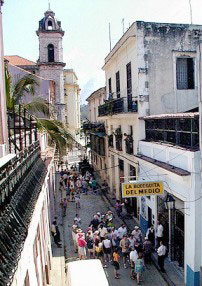 This famous restaurant located in the heart of Old Havana (Habana Vieja) opened its doors in 1942 and among the most loyal clients were intellectuals that would pop in after doing business in a nearby printing press. It was named for its position precisely in the very centre of Empedrado Street, very close to the Cathedral Plaza (Plaza de la Catedral).
One of the journalists thought to write up his name on a wall and that is how a tradition started out that persists to this day. Among the many names that figure on the walls, are Pablo Neruda, Agustín Lara, Brigitte Bardot, Ignacio Villa (Bola de Nieve), Ernest Hemingway and Salvador Allende. It is an ideal spot to enjoy typical Cuban cuisine based on rice, black beans, fried plantains, roasted pork and jerked beef in tomato sauce (tasajo entomatado), as well as the traditional mandioca (yuca).
This famous restaurant located in the heart of Old Havana (Habana Vieja) opened its doors in 1942 and among the most loyal clients were intellectuals that would pop in after doing business in a nearby printing press. It was named for its position precisely in the very centre of Empedrado Street, very close to the Cathedral Plaza (Plaza de la Catedral).
One of the journalists thought to write up his name on a wall and that is how a tradition started out that persists to this day. Among the many names that figure on the walls, are Pablo Neruda, Agustín Lara, Brigitte Bardot, Ignacio Villa (Bola de Nieve), Ernest Hemingway and Salvador Allende. It is an ideal spot to enjoy typical Cuban cuisine based on rice, black beans, fried plantains, roasted pork and jerked beef in tomato sauce (tasajo entomatado), as well as the traditional mandioca (yuca).
For more information:
www.cuba-havanacity.com
|
|
|
CEMETERY OF COLUMBUS
 A National Monument since 1987, it is a true architect’s jewel, from its impressive portico up to the history written in marble and all types of stone in its funerary structures built during the last three centuries.
The Pórtico, done in romantic style, is crowned by a sculptural ensemble created by the Cuban artist José Villalta y Saavedra and represents “Faith, Hope and Charity”, at the foot of which reads in latin: Jauna Sum Pacis (This is the gateway of peace).
It is the main necropolis of the Cuban capital where monuments to heroes and martyrs of the homeland can be seen, as well as sculptures of angels, virgins and Christs honouring illustrious men, scientists and presidents.
There are many romantic histories among the myths and legends of this solemn place, whose building begun on October 30th of 1871.
A National Monument since 1987, it is a true architect’s jewel, from its impressive portico up to the history written in marble and all types of stone in its funerary structures built during the last three centuries.
The Pórtico, done in romantic style, is crowned by a sculptural ensemble created by the Cuban artist José Villalta y Saavedra and represents “Faith, Hope and Charity”, at the foot of which reads in latin: Jauna Sum Pacis (This is the gateway of peace).
It is the main necropolis of the Cuban capital where monuments to heroes and martyrs of the homeland can be seen, as well as sculptures of angels, virgins and Christs honouring illustrious men, scientists and presidents.
There are many romantic histories among the myths and legends of this solemn place, whose building begun on October 30th of 1871.
For more information:
www.cuba-havanacity.com
,
www.cuba-easternbeaches.com
,
www.cuba-oldhavana.com
,
www.go-havana.com
,
www.tropicanacabaret.com
|
|
|
COIN HOUSE (CASA DE LA MONEDA)
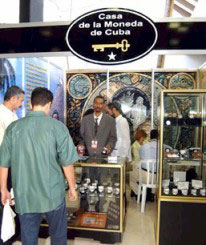 Founded on July 18th of 1977 at the intersection of Aguiar and Obrapía, in Old Havana. Since its opening and until 1989 it belonged to the Cuban National Bank (Banco Nacional de Cuba), a period in which it was dedicated mainly to coining commemorative pieces, as well as small quantities of circulating coins, among others.
The present day factory opened on March sixth of 1991, featuring a more modern technology and fully equipped for coining legal tender. The high quality of its productions has allowed it to take on national and international commercialisation of all products and services mentioned previously, including the export and import of raw materials employed in the productive process and in commercial activity.
Founded on July 18th of 1977 at the intersection of Aguiar and Obrapía, in Old Havana. Since its opening and until 1989 it belonged to the Cuban National Bank (Banco Nacional de Cuba), a period in which it was dedicated mainly to coining commemorative pieces, as well as small quantities of circulating coins, among others.
The present day factory opened on March sixth of 1991, featuring a more modern technology and fully equipped for coining legal tender. The high quality of its productions has allowed it to take on national and international commercialisation of all products and services mentioned previously, including the export and import of raw materials employed in the productive process and in commercial activity.
For more information:
www.cuba-havanacity.com
,
www.cuba-coins.com
,
www.cuba-oldhavana.com
|
|
|
CUBA’S NATIONAL LIBRARY (BIBLIOTECA NACIONAL DE CUBA)
 This building is among those surrounding the Revolution’s Plaza, but the institution was founded on October 18th of 1901. Its initial location, was in the Castle of the Forces (Castillo de la Fuerza) where it had only 3 151 books.
It wasn’t until 1949 when by an idea of Don Fernando Ortíz, the council of sponsors decided to name the building José Martí, which would be built years later, when the first stone was laid on January 28th of 1952, and declared as officially constructed on June 12th of 1957, when the building was opened after the National Library was moved into it.
This building is among those surrounding the Revolution’s Plaza, but the institution was founded on October 18th of 1901. Its initial location, was in the Castle of the Forces (Castillo de la Fuerza) where it had only 3 151 books.
It wasn’t until 1949 when by an idea of Don Fernando Ortíz, the council of sponsors decided to name the building José Martí, which would be built years later, when the first stone was laid on January 28th of 1952, and declared as officially constructed on June 12th of 1957, when the building was opened after the National Library was moved into it.
For more information:
www.cuba-havanacity.com
,
www.cuba-history.com
|
|
|
EL CACAHUAL
 Solemn group of monuments inaugurated on December 7th of 1900. Since then it honours the memory of two brave Cuban warriors, Antonio Maceo Grajales and Panchito Gómez Toro. There, a blunt column rises in the same place where both patriots were buried for the first time. This pantheon was built with money from a public collection, and on that same date a park was built that surrounds the column. Forty three years later the present day memorial was built, a work of the Cuban sculptor Teodoro Ramos Blanco.
This is a site of patriotic pilgrimage, political acts and student graduations. It extends over an area of approximately two square kilometres, and there also rest the remains of Blas Roca (1908-1987), an outstanding Cuban political figure, as well as the remains of Juan Fajardo Vega (1882-1990), who was the last to pass away among the Mambi troops that fought for Cuba’s freedom in the last days of the XIX century.
Solemn group of monuments inaugurated on December 7th of 1900. Since then it honours the memory of two brave Cuban warriors, Antonio Maceo Grajales and Panchito Gómez Toro. There, a blunt column rises in the same place where both patriots were buried for the first time. This pantheon was built with money from a public collection, and on that same date a park was built that surrounds the column. Forty three years later the present day memorial was built, a work of the Cuban sculptor Teodoro Ramos Blanco.
This is a site of patriotic pilgrimage, political acts and student graduations. It extends over an area of approximately two square kilometres, and there also rest the remains of Blas Roca (1908-1987), an outstanding Cuban political figure, as well as the remains of Juan Fajardo Vega (1882-1990), who was the last to pass away among the Mambi troops that fought for Cuba’s freedom in the last days of the XIX century.
For more information:
www.cuba-havanacity.com
,
www.cuba-heroes.com
,
www.cuba-museums.com
|
|
|
EL TEMPLETE
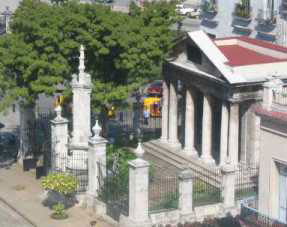 It has become a symbol of the birth of the Villa of San Cristóbal de la Habana. It is said that in this place, located in the present day Plaza de Armas, on November 16th of 1519, the colonists and neighbours met to celebrate the first mass, and at the same time, the first meeting of the Chapter House, with the aim of definitely establishing a city blessed with the salt and water of the bay, under the protection of the noble shadow of a Ceiba tree.
This Ceiba tree is the basis of an undying tradition, on each anniversary of the Villa’s founding, people walk around the tree and make a wish. It was exactly in 1828 that the Templete was built, according to a project of Cuban architect Antonio María de la Torre. The spot is a necessary visiting place, especially for those that like to immerse themselves in the roots of the city and its history.
It has become a symbol of the birth of the Villa of San Cristóbal de la Habana. It is said that in this place, located in the present day Plaza de Armas, on November 16th of 1519, the colonists and neighbours met to celebrate the first mass, and at the same time, the first meeting of the Chapter House, with the aim of definitely establishing a city blessed with the salt and water of the bay, under the protection of the noble shadow of a Ceiba tree.
This Ceiba tree is the basis of an undying tradition, on each anniversary of the Villa’s founding, people walk around the tree and make a wish. It was exactly in 1828 that the Templete was built, according to a project of Cuban architect Antonio María de la Torre. The spot is a necessary visiting place, especially for those that like to immerse themselves in the roots of the city and its history.
For more information:
www.cuba-havanacity.com
,
www.cuba-museums.com
,
www.cuba-oldhavana.com
|
|
|
ENGLAND HOTEL (HOTEL INGLATERRA)
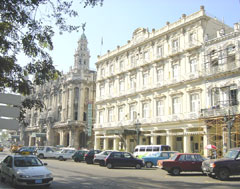 Located in the historical quarters of the Cuban capital, the hotel rises majestically across the street from the Paseo del Prado and the Central Park. From its balconies one can admire the Havana Bay. It is right next to the Great Havana Theatre (Gran Teatro de la Habana), the seat of Cuba’s National Ballet. It is a little over 100 metres from the Capitol building and near the Fine Arts Museum (Museo de Bellas Artes) and the historical centre of Havana, one of the most visited places in Cuba. This National Monument was founded in 1875 and it possesses many historical attributes that have made it a memorable destination for foreigners. Among the most attractive options are the menus where works of famous artists are pictured. This hotel is one of the seven tourist centres in the country that has received the most prizes regarding the distinguished treatment of its guests.
Located in the historical quarters of the Cuban capital, the hotel rises majestically across the street from the Paseo del Prado and the Central Park. From its balconies one can admire the Havana Bay. It is right next to the Great Havana Theatre (Gran Teatro de la Habana), the seat of Cuba’s National Ballet. It is a little over 100 metres from the Capitol building and near the Fine Arts Museum (Museo de Bellas Artes) and the historical centre of Havana, one of the most visited places in Cuba. This National Monument was founded in 1875 and it possesses many historical attributes that have made it a memorable destination for foreigners. Among the most attractive options are the menus where works of famous artists are pictured. This hotel is one of the seven tourist centres in the country that has received the most prizes regarding the distinguished treatment of its guests.
For more information:
www.cuba-havanacity.com
,
www.cuba-hotelreservations.com
,
www.fuerteventuravip.com
|
|
|
GREAT THEATER OF HAVANA
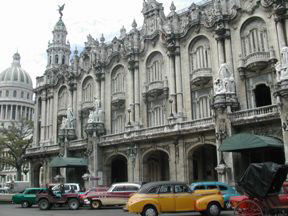 It acquired its actual name in 1985. It was previously known as Gran Teatro de Tacón, which opened in 1838. Right from the beginning, it became internationally famous and many artists from around the world performed there. After several reforms, both to its exterior as to its interior, the building was enlarged to give way to the one existing today, and is considered a faithful recreation of the German Neo-baroque style in Havana.
The present day building, built in 1908, was finally opened in 1915 with an opera season featuring important lyrical figures of the time. On its stage many artists have performed, such as Fanny Elssler, Anna Pávlova, Antonia Mercé, Ruth Saint Denis, Ted Shawn, Vicente Escudero, Maya Plisetskaya, Carla Fracci and Alicia Alonso, as well as famous ballet companies. Today it is the permanent headquarters of the National Ballet of Cuba and the main stage for the International Ballet Festivals of Havana.
It acquired its actual name in 1985. It was previously known as Gran Teatro de Tacón, which opened in 1838. Right from the beginning, it became internationally famous and many artists from around the world performed there. After several reforms, both to its exterior as to its interior, the building was enlarged to give way to the one existing today, and is considered a faithful recreation of the German Neo-baroque style in Havana.
The present day building, built in 1908, was finally opened in 1915 with an opera season featuring important lyrical figures of the time. On its stage many artists have performed, such as Fanny Elssler, Anna Pávlova, Antonia Mercé, Ruth Saint Denis, Ted Shawn, Vicente Escudero, Maya Plisetskaya, Carla Fracci and Alicia Alonso, as well as famous ballet companies. Today it is the permanent headquarters of the National Ballet of Cuba and the main stage for the International Ballet Festivals of Havana.
For more information:
www.cuba-havanacity.com
,
www.cubanculture.com
,
www.cuba-musical.com
,
www.cuba-oldhavana.com
,
www.cuban-culture.com
|
|
|
Guanabacoa
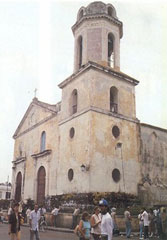 On June 12th of 1554, it was founded as the Town of the Indians (Pueblo de Indios) and a year later, for the space of six months, it became the temporal capital of the island due to the attack of the French corsair Jacques de Sores. Today there are buildings related to history, among them the ancient Lyceum (Liceo Artístico y Literario), where José Martí made his first public speech in Cuba, and the Temple of Potosi (Ermita del Potosí), an ancient architectural jewel of the period. It became the Villa of Our Lady of Asuncion of Guanabacoa (Villa de Nuestra Señora de la Asunción de Guanabacoa) on August 14th 1743.
It is also known as the Villa of Pepe Antonio, and is the second municipality in territorial extension in the province of Havana City. It features deep religious roots, both catholic as well as those from African origin, and it treasures its historical quarters which were declared a National Monument in 1990.
On June 12th of 1554, it was founded as the Town of the Indians (Pueblo de Indios) and a year later, for the space of six months, it became the temporal capital of the island due to the attack of the French corsair Jacques de Sores. Today there are buildings related to history, among them the ancient Lyceum (Liceo Artístico y Literario), where José Martí made his first public speech in Cuba, and the Temple of Potosi (Ermita del Potosí), an ancient architectural jewel of the period. It became the Villa of Our Lady of Asuncion of Guanabacoa (Villa de Nuestra Señora de la Asunción de Guanabacoa) on August 14th 1743.
It is also known as the Villa of Pepe Antonio, and is the second municipality in territorial extension in the province of Havana City. It features deep religious roots, both catholic as well as those from African origin, and it treasures its historical quarters which were declared a National Monument in 1990.
For more information:
www.cuba-havanacity.com
,
www.cuba-history.com
|
|
|
HAVANA CATHEDRAL (CATEDRAL DE LA HABANA)
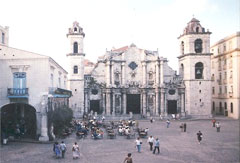 It is an example of baroque influence on architecture in the Island. Since 1782 the building had been conceived as a sanctuary by the Jesuits, who had it built next to their seminar to honour the Purísima Concepción and San Cristóbal of La Habana, patron of the city. Years later, in 1793, the Royal Decree (Real Cédula) conferred upon it the title of Cathedral, under the order of the first bishop, and since then it has become the main temple of Catholicism in Cuba.
Here, the visitors come attracted by the choir of canons sculpted in precious woods with candleholders and gold medallions, as well as by the solid sculpture of San Cristóbal and by the figure of La Concepción, crowned in the XVIII century. This beautiful temple is located in the heart of Old Havana and is surrounded by many tourist attractions.
It is an example of baroque influence on architecture in the Island. Since 1782 the building had been conceived as a sanctuary by the Jesuits, who had it built next to their seminar to honour the Purísima Concepción and San Cristóbal of La Habana, patron of the city. Years later, in 1793, the Royal Decree (Real Cédula) conferred upon it the title of Cathedral, under the order of the first bishop, and since then it has become the main temple of Catholicism in Cuba.
Here, the visitors come attracted by the choir of canons sculpted in precious woods with candleholders and gold medallions, as well as by the solid sculpture of San Cristóbal and by the figure of La Concepción, crowned in the XVIII century. This beautiful temple is located in the heart of Old Havana and is surrounded by many tourist attractions.
For more information:
www.cuba-havanacity.com
,
www.cuba-history.com
,
www.cuba-oldhavana.com
|
|
|
HAVANA CITY
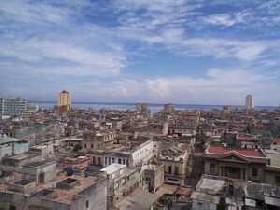 Founded in 1519 as the Villa of San Cristóbal de La Habana, it is the capital of Cuba and the country’s main tourist destination.
More than a century ago, the Villa was threatened by corsairs and pirates. In reply to this menace many defensive castles, walls, towers and other buildings were constructed, whose names today are familiar among the population: La Fuerza, El Morro, La Cabaña, La Chorrera, Cojímar, La Punta.
With the La Giraldilla as an identifying symbol, Havana City was baptised by the writer Alejo Carpentier as the City of the Columns. It occupies a surface area of 727 square kilometres with a population of over two million people in its fifteen municipalities.
In its entire northern coastline there are dozens of beautiful beaches, as well as several rivers.
Founded in 1519 as the Villa of San Cristóbal de La Habana, it is the capital of Cuba and the country’s main tourist destination.
More than a century ago, the Villa was threatened by corsairs and pirates. In reply to this menace many defensive castles, walls, towers and other buildings were constructed, whose names today are familiar among the population: La Fuerza, El Morro, La Cabaña, La Chorrera, Cojímar, La Punta.
With the La Giraldilla as an identifying symbol, Havana City was baptised by the writer Alejo Carpentier as the City of the Columns. It occupies a surface area of 727 square kilometres with a population of over two million people in its fifteen municipalities.
In its entire northern coastline there are dozens of beautiful beaches, as well as several rivers.
For more information:
www.cuba-havanacity.com
,
www.cuba-easternbeaches.com
,
www.cuba-oldhavana.com
,
www.go-havana.com
,
www.tropicanacabaret.com
|
|
|
HAVANA’S CHINA TOWN (BARRIO CHINO LA HABANA)
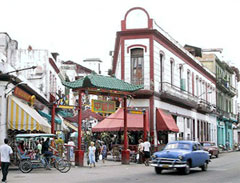 It dates back to June of 1847 when the first 260 Chinese arrived in Havana. They came filled with dreams and hopes, searching for jobs in the Spanish Crown’s most important colony.
The eight-year contract that they had signed was a deceit in order to turn them into slaves. Since then this country received the Chinese people that together with the Negroes and white races, became the beautiful mixed heritage that the Cubans inherited. They also enriched our culture with culinary recipes and medicines.
After the revolution’s triumph, some left for other countries while others stayed to share the new life of their adopted country. There are a variety of commercial shops and restaurants that keep the traditions alive while offering the visitor a pleasant stay.
It dates back to June of 1847 when the first 260 Chinese arrived in Havana. They came filled with dreams and hopes, searching for jobs in the Spanish Crown’s most important colony.
The eight-year contract that they had signed was a deceit in order to turn them into slaves. Since then this country received the Chinese people that together with the Negroes and white races, became the beautiful mixed heritage that the Cubans inherited. They also enriched our culture with culinary recipes and medicines.
After the revolution’s triumph, some left for other countries while others stayed to share the new life of their adopted country. There are a variety of commercial shops and restaurants that keep the traditions alive while offering the visitor a pleasant stay.
For more information:
www.cuba-havanacity.com
,
www.cuba-history.com
|
|
|
LA JUNTA LOCOMOTIVE ENGINE
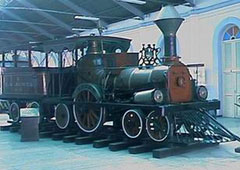 This engine was manufactured in 1843 and is considered the most ancient of those existing in Cuba and has been declared a National Monument. It is the pride of the Cuban Railway Museum (Museo del Ferrocarril Cubano) which is located in the hundred year old Cristina Station (Estación Cristina), in the centre of Havana City.
It was the insignia locomotive engine of the Matanzas Railways and boasted the Nº 1 for several decades. The exact date when it stopped offering its services is unknown, but it is said that it is one of the oldest, the most original and the best preserved of the locomotive engines built in the United States, a true relic of great value for the history of railway technology.
This machine has kept its general design characteristics intact, as well as an important group of mechanisms from the time period in which it was manufactured, that show normal wear after so many years of use.
Long Text>
This engine was manufactured in 1843 and is considered the most ancient of those existing in Cuba and has been declared a National Monument. It is the pride of the Cuban Railway Museum (Museo del Ferrocarril Cubano) which is located in the hundred year old Cristina Station (Estación Cristina), in the centre of Havana City.
It was the insignia locomotive engine of the Matanzas Railways and boasted the Nº 1 for several decades. The exact date when it stopped offering its services is unknown, but it is said that it is one of the oldest, the most original and the best preserved of the locomotive engines built in the United States, a true relic of great value for the history of railway technology.
This machine has kept its general design characteristics intact, as well as an important group of mechanisms from the time period in which it was manufactured, that show normal wear after so many years of use.
Long Text>
For more information:
www.cuba-havanacity.com
,
www.cuba-museums.com
,
www.cuba-oldhavana.com
,
www.cuba-transport.com
|
|
|
LATIN AMERICAN STADIUM
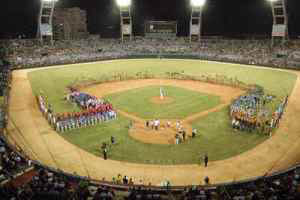 Located in the capital municipality of El Cerro, it rises up as one of the most symbolic Cuban sports installations and is a main scenario of baseball, the national sport of the Island. It was opened on October 26th of 1946. It treasures a history full of important episodes beyond sports achievements. It is next to the busy Corner of Tejas (Esquina de Tejas) a place of the confluence of the avenues of Infanta, Monte, Cerro and Jesús del Monte, today known as Diez de Octubre.
This baseball park was extensively remodelled in 1971, allowing a larger capacity of more than 50 000 spectators. First it was the main scene for the so called winter leagues of professional baseball in Cuba; later, it witnessed the beginning of the national championships which were free of professionalism, as well as becoming a seat for many world tournaments where Cuba has shown its quality in a sport that started being practiced in the country as far back as 1874.
Located in the capital municipality of El Cerro, it rises up as one of the most symbolic Cuban sports installations and is a main scenario of baseball, the national sport of the Island. It was opened on October 26th of 1946. It treasures a history full of important episodes beyond sports achievements. It is next to the busy Corner of Tejas (Esquina de Tejas) a place of the confluence of the avenues of Infanta, Monte, Cerro and Jesús del Monte, today known as Diez de Octubre.
This baseball park was extensively remodelled in 1971, allowing a larger capacity of more than 50 000 spectators. First it was the main scene for the so called winter leagues of professional baseball in Cuba; later, it witnessed the beginning of the national championships which were free of professionalism, as well as becoming a seat for many world tournaments where Cuba has shown its quality in a sport that started being practiced in the country as far back as 1874.
For more information:
www.cuba-havanacity.com
,
www.cuba-sport.com
,
www.cubasports.com
|
|
|
MELLA PLAZA
Located at the intersection of the streets of San Lázaro and Neptuno, right in front of the stone steps of the University of Havana.
This site, declared a National Monument, contains the ashes of Julio Antonio Mella, founder of the Student University Federation (Federación Estudiantil Universitaria: FEU) and of the first Communist Party of Cuba.
The black and white contrasting shades of its steel walls, face a solid bronze bust that is a reminder of the student fighter’s effigy, from which emanate the magnificent dates of his university life: MCMIII, MCMXXIII, MCMXXV, MCMXXIX, that of his birth, that of the FEU’s Founding, the Communist Party, and the fatal year of 1929 when he was assassinated in Mexico.
The sculptural complex is a site of pilgrimage for every visitor that wishes to know all about the political events that shaped Cuba into what it is today.
For more information:
www.cuba-havanacity.com
,
www.cuba-heroes.com
,
www.cuba-history.com
|
|
|
MUSEUM-HOUSE OF DULCE MARÍA LOYNAZ
 The residence of the famous poetess, National Literature Prize (1988) and Cervantes Prize (1992), was converted into a Museum honouring the most talented Cuban writer of the XX century (1902-1997).
This building was restored with the cooperation of the Junta de Andalucía and Cuba, and it housed great celebrities of Spanish literature such as Federico García Lorca and Gabriela Mistral.
The place has three uses: it is the seat of the Cuban Academy of Language (Academia Cubana de la Lengua); it is also a Centre for promoting literature and a Museum dedicated to the life and works of Dulce Maria Loynaz.
The Cultural Centre is located in the busy capital neighbourhood of El Vedado (19 and C) where the Loynaz family always lived, headed by the Major General of the Independence War Enrique Loynaz del Castillo, father of Dulce María, against Spanish colonialism. The reasons for this residence being considered as a National Monument are more than enough.
The residence of the famous poetess, National Literature Prize (1988) and Cervantes Prize (1992), was converted into a Museum honouring the most talented Cuban writer of the XX century (1902-1997).
This building was restored with the cooperation of the Junta de Andalucía and Cuba, and it housed great celebrities of Spanish literature such as Federico García Lorca and Gabriela Mistral.
The place has three uses: it is the seat of the Cuban Academy of Language (Academia Cubana de la Lengua); it is also a Centre for promoting literature and a Museum dedicated to the life and works of Dulce Maria Loynaz.
The Cultural Centre is located in the busy capital neighbourhood of El Vedado (19 and C) where the Loynaz family always lived, headed by the Major General of the Independence War Enrique Loynaz del Castillo, father of Dulce María, against Spanish colonialism. The reasons for this residence being considered as a National Monument are more than enough.
For more information:
www.cuba-havanacity.com
,
www.cuba-famous.com
,
www.cuba-history.com
,
www.cuba-literature.com
,
www.cuba-museums.com
|
|
|
NATAL HOUSE OF RUBÉN MARTÍNEZ VILLENA
 It is one of the buildings that was declared a National Monument due to its historical importance, located on Avenue 91 number 8 427, in Alquilar, in the southwest of Havana. Here Rubén Martínez Villena was born, who fought for social improvement in the country during the thirties decade of the past century.
Typical walls and wooden flooring, tile roofs, earth patio and portal, were details of the house that Luciano Martínez, his father, won in a contest to obtain a position as a teacher.
On January 16th of 1950 Juan Marinello, representing the Popular Socialist Party (Partido Socialista Popular), unveiled the honorary plaque that rediscovers and identifies from that moment on, the birthplace of this historical figure. The Museum-House opened its doors to the public on January 16th of 1976 and became the first institution of this nature in Havana Province.
It is one of the buildings that was declared a National Monument due to its historical importance, located on Avenue 91 number 8 427, in Alquilar, in the southwest of Havana. Here Rubén Martínez Villena was born, who fought for social improvement in the country during the thirties decade of the past century.
Typical walls and wooden flooring, tile roofs, earth patio and portal, were details of the house that Luciano Martínez, his father, won in a contest to obtain a position as a teacher.
On January 16th of 1950 Juan Marinello, representing the Popular Socialist Party (Partido Socialista Popular), unveiled the honorary plaque that rediscovers and identifies from that moment on, the birthplace of this historical figure. The Museum-House opened its doors to the public on January 16th of 1976 and became the first institution of this nature in Havana Province.
For more information:
www.cuba-havanacity.com
,
www.cuba-heroes.com
,
www.cuba-museums.com
|
|
|
NATIONAL AQUARIUM
 Founded on January 23rd of 1960 with only a few fish tanks and ponds, thirteen years later it received its first marine mammal, a sea lion (Artocephalus pusillus) baptised with the name Silvia. In 1985 the shows started with Diana and Ciclón, two bottlenose dolphins (Tursiops truncatus).
On January 14th of 2002 the first stage in the enlargement was finished, where a dolphin area was included with a capacity for 1 200 spectators and shows allowing the simultaneous performance of up to 8 animals.
At the same time a specialised restaurant was built for 120 people, while the recreation and commercial areas multiplied, making the visit more enjoyable for the thousands of visitors that come to the Aquarium, located in the capital’s residential neighbourhood of Miramar.
Founded on January 23rd of 1960 with only a few fish tanks and ponds, thirteen years later it received its first marine mammal, a sea lion (Artocephalus pusillus) baptised with the name Silvia. In 1985 the shows started with Diana and Ciclón, two bottlenose dolphins (Tursiops truncatus).
On January 14th of 2002 the first stage in the enlargement was finished, where a dolphin area was included with a capacity for 1 200 spectators and shows allowing the simultaneous performance of up to 8 animals.
At the same time a specialised restaurant was built for 120 people, while the recreation and commercial areas multiplied, making the visit more enjoyable for the thousands of visitors that come to the Aquarium, located in the capital’s residential neighbourhood of Miramar.
For more information:
www.cuba-havanacity.com
|
|
|
NATIONAL CAPITOL
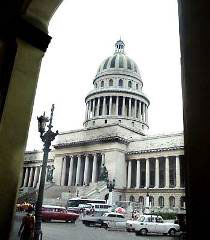 A monumental building located almost at the end of the famous Havana Paseo del Prado. It was built during the years of 1926 to 1929 and in the beginning harboured the legislative corps of the Republic. The National Capitol became one of the symbols that distinguish not only Havana City but also Cuba. To roam its inner chambers is to discover rooms and hallways that are historical treasures, such is its value that architects place it among the six most important palaces in the world.
With an independent access, it can be contemplated as part of the tour of the Museum of Natural Sciences that is located in one of the lower levels. It also houses the central dependencies of the Ministry of Science, Technology and the Environment.
A monumental building located almost at the end of the famous Havana Paseo del Prado. It was built during the years of 1926 to 1929 and in the beginning harboured the legislative corps of the Republic. The National Capitol became one of the symbols that distinguish not only Havana City but also Cuba. To roam its inner chambers is to discover rooms and hallways that are historical treasures, such is its value that architects place it among the six most important palaces in the world.
With an independent access, it can be contemplated as part of the tour of the Museum of Natural Sciences that is located in one of the lower levels. It also houses the central dependencies of the Ministry of Science, Technology and the Environment.
For more information:
www.cuba-havanacity.com
|
|
|
National Hotel of Cuba
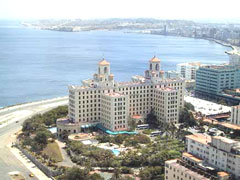 Declared a National Monument by the Ministry of Cuban Culture and a Heritage of Humanity by the UNESCO, it is located in a privileged sea front area from which most of the Havana Bay can be seen, as well as the malecon and the Vedado neighbourhood.
With a five star category, this legendary hotel features over 400 rooms, most of them with a seaside view, of these 16 are suites and one is a Presidential suite. It also boasts an executive board, several bars, restaurants, cafeterias, stores, tobacco shop (Casa del Habano) and the distinctive Cabaret Parisién. It is undoubtedly a very luxurious place and much preferred by many for decades. It has housed personalities such as Winston Churchill, British Prime Minister, the artists Frank Sinatra, Ava Gardner, Johnny Weismuller, María Félix and Jorge Negrete, as well as renowned politicians, athletes and scientists, among others.
Declared a National Monument by the Ministry of Cuban Culture and a Heritage of Humanity by the UNESCO, it is located in a privileged sea front area from which most of the Havana Bay can be seen, as well as the malecon and the Vedado neighbourhood.
With a five star category, this legendary hotel features over 400 rooms, most of them with a seaside view, of these 16 are suites and one is a Presidential suite. It also boasts an executive board, several bars, restaurants, cafeterias, stores, tobacco shop (Casa del Habano) and the distinctive Cabaret Parisién. It is undoubtedly a very luxurious place and much preferred by many for decades. It has housed personalities such as Winston Churchill, British Prime Minister, the artists Frank Sinatra, Ava Gardner, Johnny Weismuller, María Félix and Jorge Negrete, as well as renowned politicians, athletes and scientists, among others.
For more information:
www.cuba-havanacity.com
,
www.cuba-history.com
,
www.cuba-hotelreservations.com
|
|
|
NATIONAL ZOO PARK
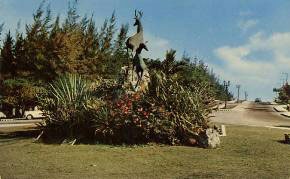 With two centres in the capital, it carries out multiple tasks such as recreational, educational, cultural and research activities related to native and exotic fauna in captivity. It has become a centre for exhibiting Cuban and foreign fauna and at the same time it controls protected or endangered species, carrying out research in order to guarantee their reproduction and raising in captivity. It also educates the population on the importance of the conservation of fauna.
An aviary is being built in order to exhibit Cuban birds from the savannas and wet ecosystems. The exhibit will be interactive, since the public will access it through the same grotto where many species can be seen. It will be the first of its kind in the country.
With two centres in the capital, it carries out multiple tasks such as recreational, educational, cultural and research activities related to native and exotic fauna in captivity. It has become a centre for exhibiting Cuban and foreign fauna and at the same time it controls protected or endangered species, carrying out research in order to guarantee their reproduction and raising in captivity. It also educates the population on the importance of the conservation of fauna.
An aviary is being built in order to exhibit Cuban birds from the savannas and wet ecosystems. The exhibit will be interactive, since the public will access it through the same grotto where many species can be seen. It will be the first of its kind in the country.
For more information:
www.cuba-havanacity.com
,
www.cuba-zoo.com
|
|
|
OLD HAVANA
 Hailed by UNESCO as a Heritage of Humanity, it treasures dozens of places in a quite flat area of about 4,5 square kilometres.
Ancient fortresses, palaces built during the XVII, XVIII and XIX centuries, museums of enormous historical value, emblematic restaurants such as La Bodeguita del Medio or the Plaza of Havana’s Cathedral (Plaza de la Catedral de la Havana), surrounded by centuries-old buildings; are places that the tourist should include in their itinerary in order to contemplate it in its real dimension, the true legacy of the Cuban capital’s historical quarters.
Hailed by UNESCO as a Heritage of Humanity, it treasures dozens of places in a quite flat area of about 4,5 square kilometres.
Ancient fortresses, palaces built during the XVII, XVIII and XIX centuries, museums of enormous historical value, emblematic restaurants such as La Bodeguita del Medio or the Plaza of Havana’s Cathedral (Plaza de la Catedral de la Havana), surrounded by centuries-old buildings; are places that the tourist should include in their itinerary in order to contemplate it in its real dimension, the true legacy of the Cuban capital’s historical quarters.
For more information:
www.cuba-havanacity.com
,
www.cuba-easternbeaches.com
,
www.cuba-oldhavana.com
,
www.go-havana.com
,
www.tropicanacabaret.com
|
|
|
PLAZA OF THE REVOLUTION
 This is quite an emblematic place for the Cubans due to the fact that on this wide esplanade many political, cultural or recreational acts have taken place.
The Plaza is surrounded by many buildings, such as the National Theatre (Teatro Nacional) and the National Library (Biblioteca Nacional), as well as the Ministries of Communications, the Revolutionary Armed Forces and of the Interior, whose facade features the figure of the symbolic warrior Ernesto Che Guevara.
A gigantic sculpture of José Martí, Cuba’s National Hero, at the foot of the challenging monument, from whose lookout a good part of the city can be appreciated, preside over the Plaza, the image of which is photographed daily by people who have come from every corner of the earth.
This is quite an emblematic place for the Cubans due to the fact that on this wide esplanade many political, cultural or recreational acts have taken place.
The Plaza is surrounded by many buildings, such as the National Theatre (Teatro Nacional) and the National Library (Biblioteca Nacional), as well as the Ministries of Communications, the Revolutionary Armed Forces and of the Interior, whose facade features the figure of the symbolic warrior Ernesto Che Guevara.
A gigantic sculpture of José Martí, Cuba’s National Hero, at the foot of the challenging monument, from whose lookout a good part of the city can be appreciated, preside over the Plaza, the image of which is photographed daily by people who have come from every corner of the earth.
For more information:
www.cuba-havanacity.com
,
www.cuba-easternbeaches.com
,
www.cuba-oldhavana.com
,
www.go-havana.com
,
www.tropicanacabaret.com
|
|
|
QUINTA DE LOS MOLINOS
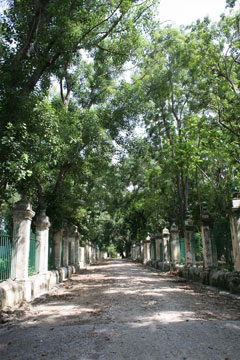 The century old building is found on Salvador Allende Avenue, previously called Carlos III. It has been transformed into a Museum that honours the memory of the Mambi General Máximo Gómez and in 1986 it was declared a National Monument.
It was built in the second half of the XIX century with the idea that it serve as a summer residence for the Spanish Captain Generals of the Republic, and at the same time as a house for them after they had finished their term but stayed on the island before leaving for Spain.
The beautiful building is based on a one story construction without great pretensions. Its greatest jewel lies in the extensive gardens that surround it, decorated with statues, fountains, small waterfalls, a summer house, grottoes and an abundant and valuable plant life, which were brought from the ancient Botanical Gardens that existed in La Habana at the time.
The century old building is found on Salvador Allende Avenue, previously called Carlos III. It has been transformed into a Museum that honours the memory of the Mambi General Máximo Gómez and in 1986 it was declared a National Monument.
It was built in the second half of the XIX century with the idea that it serve as a summer residence for the Spanish Captain Generals of the Republic, and at the same time as a house for them after they had finished their term but stayed on the island before leaving for Spain.
The beautiful building is based on a one story construction without great pretensions. Its greatest jewel lies in the extensive gardens that surround it, decorated with statues, fountains, small waterfalls, a summer house, grottoes and an abundant and valuable plant life, which were brought from the ancient Botanical Gardens that existed in La Habana at the time.
For more information:
www.cuba-havanacity.com
,
www.cuba-architecture.com
,
www.cuba-heroes.com
,
www.cuba-history.com
|
|
|
REMEDIOS
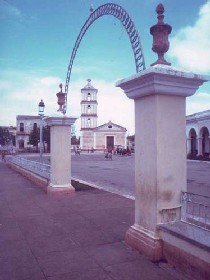 San Juan de los Remedios was the eighth villa founded by the Spanish in 1515. The historical centre was declared a National Monument in 1980 and has a unique plaza, since it is the only one in the country where two churches stand: Our Lady of the Good Trip (Nuestra Señora del Buen Viaje) and the Parroquia Mayor, in the latter there is a huge altar gilded in gold leaf and a sculpture representing the pregnant Immaculate Conception, which is said to be unique in the whole world.
Another main attraction is the so-called “Parrandas de Remedios”, which are fun festivities originating on the eve of every December 24th and always extending until Christmas morning.
Another featured attraction for those who enjoy health tourism is the Elguea Spa (Balneario de Elguea), rich in medicinal waters. The centre is gifted with modern equipment, and among the multiple options to choose from there are anti-stress treatments.
San Juan de los Remedios was the eighth villa founded by the Spanish in 1515. The historical centre was declared a National Monument in 1980 and has a unique plaza, since it is the only one in the country where two churches stand: Our Lady of the Good Trip (Nuestra Señora del Buen Viaje) and the Parroquia Mayor, in the latter there is a huge altar gilded in gold leaf and a sculpture representing the pregnant Immaculate Conception, which is said to be unique in the whole world.
Another main attraction is the so-called “Parrandas de Remedios”, which are fun festivities originating on the eve of every December 24th and always extending until Christmas morning.
Another featured attraction for those who enjoy health tourism is the Elguea Spa (Balneario de Elguea), rich in medicinal waters. The centre is gifted with modern equipment, and among the multiple options to choose from there are anti-stress treatments.
For more information:
www.cuba-cayosantamaria.com
,
www.cuba-elguea.com
,
www.cuba-villaclara.com
,
www.cuba-cayolasbrujas.com
|
|
|
SAN FRANCISCO DE ASIS CONVENT
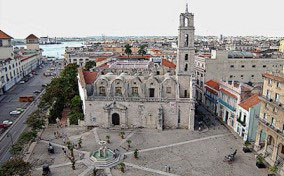 Located in the historical area of the Cuban capital, this convent has been named by UNESCO as a Patrimony of Humanity. The plaza which accesses it is considered as one of the first three in Havana due to its antiquity. It is named Plaza de San Francisco de Asis because it was built by the Franciscan monks who started construction on both the convent and the plaza in 1574 and finished in 1591.
Many consider these spots as one of the most charming that the old city possesses. Among it surroundings, is the Commerce Exchange (Lonja del Comercio), the cruise ship terminal, restaurants, cafeterias, boutiques, postal office, banks, currency exchange houses and other cultural centres. As part of the charm of the well preserved construction, the building is used as a concert theatre, featuring good music from famous groups or soloists.
Located in the historical area of the Cuban capital, this convent has been named by UNESCO as a Patrimony of Humanity. The plaza which accesses it is considered as one of the first three in Havana due to its antiquity. It is named Plaza de San Francisco de Asis because it was built by the Franciscan monks who started construction on both the convent and the plaza in 1574 and finished in 1591.
Many consider these spots as one of the most charming that the old city possesses. Among it surroundings, is the Commerce Exchange (Lonja del Comercio), the cruise ship terminal, restaurants, cafeterias, boutiques, postal office, banks, currency exchange houses and other cultural centres. As part of the charm of the well preserved construction, the building is used as a concert theatre, featuring good music from famous groups or soloists.
For more information:
www.cuba-havanacity.com
,
www.cuba-oldhavana.com
|
|
|
SANTA CLARA
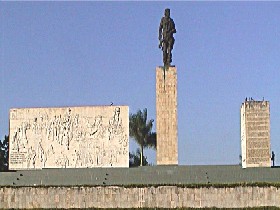 Capital of the province of Villa Clara, its founding dates back to 1689. It is some 270 kilometres east of Havana. It is a typical city and many of its inhabitants live in brick houses with red clay roof tiles, in a quaint reminder of small Spanish villages.
Many identify it as the city of Che, due to the fact that in this city the Heroic Warrior fought at the head of his invading column for Cuba’s freedom, one of the last struggles for independence in December of 1958.
Millions of people have visited the Memorial Ernesto Che Guevara, located at the doors of Santa Clara and raised in honour of Che and the rest of the warriors that fought by his side in Bolivia.
In this esplanade many political acts and graduations have been celebrated, among other activities. It was also the scene of a giant chess competition on April 29th of 2004, with the presence of over 13 000 players.
Capital of the province of Villa Clara, its founding dates back to 1689. It is some 270 kilometres east of Havana. It is a typical city and many of its inhabitants live in brick houses with red clay roof tiles, in a quaint reminder of small Spanish villages.
Many identify it as the city of Che, due to the fact that in this city the Heroic Warrior fought at the head of his invading column for Cuba’s freedom, one of the last struggles for independence in December of 1958.
Millions of people have visited the Memorial Ernesto Che Guevara, located at the doors of Santa Clara and raised in honour of Che and the rest of the warriors that fought by his side in Bolivia.
In this esplanade many political acts and graduations have been celebrated, among other activities. It was also the scene of a giant chess competition on April 29th of 2004, with the presence of over 13 000 players.
For more information:
www.cuba-cayosantamaria.com
,
www.cuba-elguea.com
,
www.cuba-villaclara.com
,
www.cuba-cayolasbrujas.com
|
|
|
TEMPLE OF POTOSI (ERMITA DEL POTOSÍ)
 This ancient building was declared a National Monument on April 23rd of 1997.
It is located in the angle formed by the Calzada de Guanabacoa and Potosí Street in the historical capital, also known as the Villa of Pepe Antonio, and occupies an outstanding place in history and legends.
The Temple was built in 1644 as a tribute to the Immaculate Concepción de María.
It is built in Moroccan style, its roofs are of wooden panelling with all the typical elements that characterise this type of architecture.
The headboard is semi octagonal, while on the outside its eaves are shingled. Inside the Temple two sepulchres can be seen.
This ancient building was declared a National Monument on April 23rd of 1997.
It is located in the angle formed by the Calzada de Guanabacoa and Potosí Street in the historical capital, also known as the Villa of Pepe Antonio, and occupies an outstanding place in history and legends.
The Temple was built in 1644 as a tribute to the Immaculate Concepción de María.
It is built in Moroccan style, its roofs are of wooden panelling with all the typical elements that characterise this type of architecture.
The headboard is semi octagonal, while on the outside its eaves are shingled. Inside the Temple two sepulchres can be seen.
For more information:
www.cuba-havanacity.com
,
www.cuba-architecture.com
,
www.cuba-history.com
|
|
|
The Butterfly (National Flower)
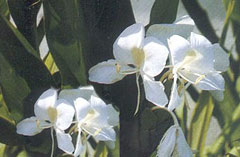 On October 13th of 1936 the Butterfly (Mariposa) was declared the national flower. Its scientific name is Hedychium Coronarium Koenig, from the Zingiberáceas family (alpináceans). It is not native of the island, but originated in Asia, nevertheless it has adapted itself very well to our moist earth. Its whiteness represents the purity of the ideas of independence and it is a symbol of peace. According to spoken tradition, during the independence wars, inside these flowers pinned on women’s veils and shawls, were hidden messages for the Liberating Army (ejército libertador). The Mariposa has well earned its condition of national flower.
On October 13th of 1936 the Butterfly (Mariposa) was declared the national flower. Its scientific name is Hedychium Coronarium Koenig, from the Zingiberáceas family (alpináceans). It is not native of the island, but originated in Asia, nevertheless it has adapted itself very well to our moist earth. Its whiteness represents the purity of the ideas of independence and it is a symbol of peace. According to spoken tradition, during the independence wars, inside these flowers pinned on women’s veils and shawls, were hidden messages for the Liberating Army (ejército libertador). The Mariposa has well earned its condition of national flower.
For more information:
www.cuba-botanicalgardens.com
,
www.cuba-flora.com
,
www.cuba-history.com
|
|
|
THE NINE O’CLOCK CANNON FIRE (EL CAÑONAZO DE LAS NUEVE)
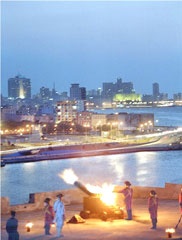 Every day, always at nine at night, a good part of Havana hears the deep sound of a familiar shot. It is the traditional cannon shot that marks exactly 2100 hours. This is carried out by skilled hands operating an ancient cannon that shoots a blank from the Fortress of San Carlos de la Cabaña (Fortaleza de San Carlos de la Cabaña), from where the Havana City landscape can be gazed upon.
The nine o’clock cannon shot, as it is popularly known in Cuba, is a tradition that started in the XVIII century, when the Fortress shot a blank at six o’clock in the morning in order to announce the opening of the City gates, that would close again at nine o’clock at night.
During ancient times, a protecting wall surrounded Havana, today remains of that wall can still be seen in Old Havana, a Heritage of Humanity.
Every day, always at nine at night, a good part of Havana hears the deep sound of a familiar shot. It is the traditional cannon shot that marks exactly 2100 hours. This is carried out by skilled hands operating an ancient cannon that shoots a blank from the Fortress of San Carlos de la Cabaña (Fortaleza de San Carlos de la Cabaña), from where the Havana City landscape can be gazed upon.
The nine o’clock cannon shot, as it is popularly known in Cuba, is a tradition that started in the XVIII century, when the Fortress shot a blank at six o’clock in the morning in order to announce the opening of the City gates, that would close again at nine o’clock at night.
During ancient times, a protecting wall surrounded Havana, today remains of that wall can still be seen in Old Havana, a Heritage of Humanity.
For more information:
www.cuba-havanacity.com
,
www.cuba-history.com
|
|
|
THE PLACE WHERE JOSÉ ANTONIO ECHEVERRÍA FELL
This historical place is located almost at the intersection of L and 27th streets in the area of El Vedado, in the capital.
This place, declared a National Monument, was where José Antonio Echeverría Bianchi (1932-1957) was gunned down on March 13th of 1957. He was a student of architecture and acted as president of the FEU.
He had started to fight since March 10th of 1952, the date of Fulgencio Batista’s coupe d’état.
The day of his murder, as part of the plan of the assault on the Presidential Palace, he took the “Radio Reloj” radio station in order to announce through its microphones that the tyrannical president had been executed. Leaving the station and returning to the University, he fell in mortal combat with Batista’s police.
For more information:
www.cuba-havanacity.com
,
www.cuba-heroes.com
,
www.cuba-history.com
|
|
|
TROPICANA CABARET
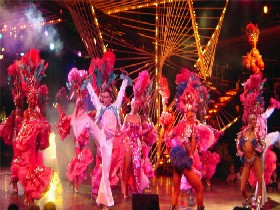 This cabaret was founded in 1939, and soon this Paradise under the stars became the favourite of those visiting the Cuban capital. This is one of the largest night clubs in the country and among its many options are restaurants, the lounge under the stars and the incomparable show awing almost a thousand spectators.
On Tropicana’s stage many famous celebrities have performed, such as Nat King Cole, Josephine Baker, los Chavales from Spain, Carmen Miranda, Pedro Vargas, Libertad Lamarque, Tania Libertad, Alejandra Guzmán, Cheo Feliciano, Celia Cruz, Olga Guillot, Elena Burke, Rita Montaner, Bola de Nieve and many others.
Since 2002 it is considered a National Monument.
This cabaret was founded in 1939, and soon this Paradise under the stars became the favourite of those visiting the Cuban capital. This is one of the largest night clubs in the country and among its many options are restaurants, the lounge under the stars and the incomparable show awing almost a thousand spectators.
On Tropicana’s stage many famous celebrities have performed, such as Nat King Cole, Josephine Baker, los Chavales from Spain, Carmen Miranda, Pedro Vargas, Libertad Lamarque, Tania Libertad, Alejandra Guzmán, Cheo Feliciano, Celia Cruz, Olga Guillot, Elena Burke, Rita Montaner, Bola de Nieve and many others.
Since 2002 it is considered a National Monument.
For more information:
www.cuba-havanacity.com
,
www.cuba-easternbeaches.com
,
www.cuba-oldhavana.com
,
www.go-havana.com
,
www.tropicanacabaret.com
|
|
|
UNIVERSITY OF HAVANA
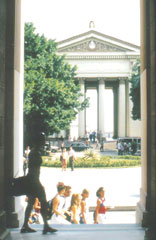 This centre of superior studies treasures an enormous amount of historical events and places, from its challenging 88 stone steps, to the statue of the Alma Máter and that of Ignacio Agramonte, the well preserved areas where important studies were carried out by famous students such as Cuba’s President Fidel Castro.
The Mella Memorial, which holds the ashes of the young student who founded the first Communist Party of Cuba back in 1925, is located in the surrounding area, as well as the place where the student leader José Antonio Echeverría was murdered in 1957.
In the University, the remains of the presbyter Félix Varela repose peacefully in the Cadena Plaza, and are also venerated. The University has had several names in over 250 years: Royal and Pontifical University of Saint Geronimo (Universidad Real y Pontificia de San Gerónimo), Royal and Literary University of Havana (Real y Literaria Universidad de La Habana) and later on it was known as the National University (Universidad Nacional).
This centre of superior studies treasures an enormous amount of historical events and places, from its challenging 88 stone steps, to the statue of the Alma Máter and that of Ignacio Agramonte, the well preserved areas where important studies were carried out by famous students such as Cuba’s President Fidel Castro.
The Mella Memorial, which holds the ashes of the young student who founded the first Communist Party of Cuba back in 1925, is located in the surrounding area, as well as the place where the student leader José Antonio Echeverría was murdered in 1957.
In the University, the remains of the presbyter Félix Varela repose peacefully in the Cadena Plaza, and are also venerated. The University has had several names in over 250 years: Royal and Pontifical University of Saint Geronimo (Universidad Real y Pontificia de San Gerónimo), Royal and Literary University of Havana (Real y Literaria Universidad de La Habana) and later on it was known as the National University (Universidad Nacional).
For more information:
www.cuba-havanacity.com
,
www.cuba-education.com
,
www.cuba-history.com
,
www.cuba-universities.com
|
|
|
WORKER’S NATIONAL CONFEDERATION OF CUBA (CONFEDERACIÓN NACIONAL OBRERA DE CUBA )
This institution was founded on August 2nd of 1925 and was a significant step for the Cuban worker’s movement. The first congress was held on that day in Camagüey, but the seat was later transferred to the present day capital municipality of Centro Habana, along San Miguel street, between Lucena and Marqués González streets, where the building is located. The building previously had been the ancient Palacio de los Torcedores.
The same place also housed the so-called José Martí Popular University, the Antimperialist League, as well as the offices of the Popular Socialist Party.
The Confederación Nacional Obrera de Cuba has maintained since its creation, a high spirit of unity, until in 1939 it gave way to the present day Worker’s Central of Cuba (Central de Trabajadores de Cuba -CTC) presided by the syndical leader Lázaro Peña.
This building has been proclaimed a National Monument.
For more information:
www.cuba-havanacity.com
,
www.cuba-history.com
,
www.cuba-josemarti.com
|
|
 One of the institutions of prestige, it is located in the intersection of G and 3rd Avenues in the neighbourhood of Vedado in Havana City. It was opened in 1959 by Haydee Santamaría, one of the two women that took part in the attack on the Moncada Garrison (Cuartel Moncada) on July 26th of 1953.
The present day House is presided over by Roberto Fernández Retamar and due to the incessant effort of many people, here the work of writers, painters, musicians, playwrights, and scholars of literature and the arts, is made public, researched and awarded.
The building features the characteristics of a temple, and it acts like one, for over four decades it has been a refuge of the best literature, art and music of Latin America and the Caribbean. Its prestigious House Award (Premio Casa) bathed in the limelight many of today’s most successful writers in the area.
One of the institutions of prestige, it is located in the intersection of G and 3rd Avenues in the neighbourhood of Vedado in Havana City. It was opened in 1959 by Haydee Santamaría, one of the two women that took part in the attack on the Moncada Garrison (Cuartel Moncada) on July 26th of 1953.
The present day House is presided over by Roberto Fernández Retamar and due to the incessant effort of many people, here the work of writers, painters, musicians, playwrights, and scholars of literature and the arts, is made public, researched and awarded.
The building features the characteristics of a temple, and it acts like one, for over four decades it has been a refuge of the best literature, art and music of Latin America and the Caribbean. Its prestigious House Award (Premio Casa) bathed in the limelight many of today’s most successful writers in the area.
 This famous restaurant located in the heart of Old Havana (Habana Vieja) opened its doors in 1942 and among the most loyal clients were intellectuals that would pop in after doing business in a nearby printing press. It was named for its position precisely in the very centre of Empedrado Street, very close to the Cathedral Plaza (Plaza de la Catedral).
One of the journalists thought to write up his name on a wall and that is how a tradition started out that persists to this day. Among the many names that figure on the walls, are Pablo Neruda, Agustín Lara, Brigitte Bardot, Ignacio Villa (Bola de Nieve), Ernest Hemingway and Salvador Allende. It is an ideal spot to enjoy typical Cuban cuisine based on rice, black beans, fried plantains, roasted pork and jerked beef in tomato sauce (tasajo entomatado), as well as the traditional mandioca (yuca).
This famous restaurant located in the heart of Old Havana (Habana Vieja) opened its doors in 1942 and among the most loyal clients were intellectuals that would pop in after doing business in a nearby printing press. It was named for its position precisely in the very centre of Empedrado Street, very close to the Cathedral Plaza (Plaza de la Catedral).
One of the journalists thought to write up his name on a wall and that is how a tradition started out that persists to this day. Among the many names that figure on the walls, are Pablo Neruda, Agustín Lara, Brigitte Bardot, Ignacio Villa (Bola de Nieve), Ernest Hemingway and Salvador Allende. It is an ideal spot to enjoy typical Cuban cuisine based on rice, black beans, fried plantains, roasted pork and jerked beef in tomato sauce (tasajo entomatado), as well as the traditional mandioca (yuca).
 A National Monument since 1987, it is a true architect’s jewel, from its impressive portico up to the history written in marble and all types of stone in its funerary structures built during the last three centuries.
The Pórtico, done in romantic style, is crowned by a sculptural ensemble created by the Cuban artist José Villalta y Saavedra and represents “Faith, Hope and Charity”, at the foot of which reads in latin: Jauna Sum Pacis (This is the gateway of peace).
It is the main necropolis of the Cuban capital where monuments to heroes and martyrs of the homeland can be seen, as well as sculptures of angels, virgins and Christs honouring illustrious men, scientists and presidents.
There are many romantic histories among the myths and legends of this solemn place, whose building begun on October 30th of 1871.
A National Monument since 1987, it is a true architect’s jewel, from its impressive portico up to the history written in marble and all types of stone in its funerary structures built during the last three centuries.
The Pórtico, done in romantic style, is crowned by a sculptural ensemble created by the Cuban artist José Villalta y Saavedra and represents “Faith, Hope and Charity”, at the foot of which reads in latin: Jauna Sum Pacis (This is the gateway of peace).
It is the main necropolis of the Cuban capital where monuments to heroes and martyrs of the homeland can be seen, as well as sculptures of angels, virgins and Christs honouring illustrious men, scientists and presidents.
There are many romantic histories among the myths and legends of this solemn place, whose building begun on October 30th of 1871.
 Founded on July 18th of 1977 at the intersection of Aguiar and Obrapía, in Old Havana. Since its opening and until 1989 it belonged to the Cuban National Bank (Banco Nacional de Cuba), a period in which it was dedicated mainly to coining commemorative pieces, as well as small quantities of circulating coins, among others.
The present day factory opened on March sixth of 1991, featuring a more modern technology and fully equipped for coining legal tender. The high quality of its productions has allowed it to take on national and international commercialisation of all products and services mentioned previously, including the export and import of raw materials employed in the productive process and in commercial activity.
Founded on July 18th of 1977 at the intersection of Aguiar and Obrapía, in Old Havana. Since its opening and until 1989 it belonged to the Cuban National Bank (Banco Nacional de Cuba), a period in which it was dedicated mainly to coining commemorative pieces, as well as small quantities of circulating coins, among others.
The present day factory opened on March sixth of 1991, featuring a more modern technology and fully equipped for coining legal tender. The high quality of its productions has allowed it to take on national and international commercialisation of all products and services mentioned previously, including the export and import of raw materials employed in the productive process and in commercial activity.
 This building is among those surrounding the Revolution’s Plaza, but the institution was founded on October 18th of 1901. Its initial location, was in the Castle of the Forces (Castillo de la Fuerza) where it had only 3 151 books.
It wasn’t until 1949 when by an idea of Don Fernando Ortíz, the council of sponsors decided to name the building José Martí, which would be built years later, when the first stone was laid on January 28th of 1952, and declared as officially constructed on June 12th of 1957, when the building was opened after the National Library was moved into it.
This building is among those surrounding the Revolution’s Plaza, but the institution was founded on October 18th of 1901. Its initial location, was in the Castle of the Forces (Castillo de la Fuerza) where it had only 3 151 books.
It wasn’t until 1949 when by an idea of Don Fernando Ortíz, the council of sponsors decided to name the building José Martí, which would be built years later, when the first stone was laid on January 28th of 1952, and declared as officially constructed on June 12th of 1957, when the building was opened after the National Library was moved into it.
 Solemn group of monuments inaugurated on December 7th of 1900. Since then it honours the memory of two brave Cuban warriors, Antonio Maceo Grajales and Panchito Gómez Toro. There, a blunt column rises in the same place where both patriots were buried for the first time. This pantheon was built with money from a public collection, and on that same date a park was built that surrounds the column. Forty three years later the present day memorial was built, a work of the Cuban sculptor Teodoro Ramos Blanco.
This is a site of patriotic pilgrimage, political acts and student graduations. It extends over an area of approximately two square kilometres, and there also rest the remains of Blas Roca (1908-1987), an outstanding Cuban political figure, as well as the remains of Juan Fajardo Vega (1882-1990), who was the last to pass away among the Mambi troops that fought for Cuba’s freedom in the last days of the XIX century.
Solemn group of monuments inaugurated on December 7th of 1900. Since then it honours the memory of two brave Cuban warriors, Antonio Maceo Grajales and Panchito Gómez Toro. There, a blunt column rises in the same place where both patriots were buried for the first time. This pantheon was built with money from a public collection, and on that same date a park was built that surrounds the column. Forty three years later the present day memorial was built, a work of the Cuban sculptor Teodoro Ramos Blanco.
This is a site of patriotic pilgrimage, political acts and student graduations. It extends over an area of approximately two square kilometres, and there also rest the remains of Blas Roca (1908-1987), an outstanding Cuban political figure, as well as the remains of Juan Fajardo Vega (1882-1990), who was the last to pass away among the Mambi troops that fought for Cuba’s freedom in the last days of the XIX century.
 It has become a symbol of the birth of the Villa of San Cristóbal de la Habana. It is said that in this place, located in the present day Plaza de Armas, on November 16th of 1519, the colonists and neighbours met to celebrate the first mass, and at the same time, the first meeting of the Chapter House, with the aim of definitely establishing a city blessed with the salt and water of the bay, under the protection of the noble shadow of a Ceiba tree.
This Ceiba tree is the basis of an undying tradition, on each anniversary of the Villa’s founding, people walk around the tree and make a wish. It was exactly in 1828 that the Templete was built, according to a project of Cuban architect Antonio María de la Torre. The spot is a necessary visiting place, especially for those that like to immerse themselves in the roots of the city and its history.
It has become a symbol of the birth of the Villa of San Cristóbal de la Habana. It is said that in this place, located in the present day Plaza de Armas, on November 16th of 1519, the colonists and neighbours met to celebrate the first mass, and at the same time, the first meeting of the Chapter House, with the aim of definitely establishing a city blessed with the salt and water of the bay, under the protection of the noble shadow of a Ceiba tree.
This Ceiba tree is the basis of an undying tradition, on each anniversary of the Villa’s founding, people walk around the tree and make a wish. It was exactly in 1828 that the Templete was built, according to a project of Cuban architect Antonio María de la Torre. The spot is a necessary visiting place, especially for those that like to immerse themselves in the roots of the city and its history.
 Located in the historical quarters of the Cuban capital, the hotel rises majestically across the street from the Paseo del Prado and the Central Park. From its balconies one can admire the Havana Bay. It is right next to the Great Havana Theatre (Gran Teatro de la Habana), the seat of Cuba’s National Ballet. It is a little over 100 metres from the Capitol building and near the Fine Arts Museum (Museo de Bellas Artes) and the historical centre of Havana, one of the most visited places in Cuba. This National Monument was founded in 1875 and it possesses many historical attributes that have made it a memorable destination for foreigners. Among the most attractive options are the menus where works of famous artists are pictured. This hotel is one of the seven tourist centres in the country that has received the most prizes regarding the distinguished treatment of its guests.
Located in the historical quarters of the Cuban capital, the hotel rises majestically across the street from the Paseo del Prado and the Central Park. From its balconies one can admire the Havana Bay. It is right next to the Great Havana Theatre (Gran Teatro de la Habana), the seat of Cuba’s National Ballet. It is a little over 100 metres from the Capitol building and near the Fine Arts Museum (Museo de Bellas Artes) and the historical centre of Havana, one of the most visited places in Cuba. This National Monument was founded in 1875 and it possesses many historical attributes that have made it a memorable destination for foreigners. Among the most attractive options are the menus where works of famous artists are pictured. This hotel is one of the seven tourist centres in the country that has received the most prizes regarding the distinguished treatment of its guests. It acquired its actual name in 1985. It was previously known as Gran Teatro de Tacón, which opened in 1838. Right from the beginning, it became internationally famous and many artists from around the world performed there. After several reforms, both to its exterior as to its interior, the building was enlarged to give way to the one existing today, and is considered a faithful recreation of the German Neo-baroque style in Havana.
The present day building, built in 1908, was finally opened in 1915 with an opera season featuring important lyrical figures of the time. On its stage many artists have performed, such as Fanny Elssler, Anna Pávlova, Antonia Mercé, Ruth Saint Denis, Ted Shawn, Vicente Escudero, Maya Plisetskaya, Carla Fracci and Alicia Alonso, as well as famous ballet companies. Today it is the permanent headquarters of the National Ballet of Cuba and the main stage for the International Ballet Festivals of Havana.
It acquired its actual name in 1985. It was previously known as Gran Teatro de Tacón, which opened in 1838. Right from the beginning, it became internationally famous and many artists from around the world performed there. After several reforms, both to its exterior as to its interior, the building was enlarged to give way to the one existing today, and is considered a faithful recreation of the German Neo-baroque style in Havana.
The present day building, built in 1908, was finally opened in 1915 with an opera season featuring important lyrical figures of the time. On its stage many artists have performed, such as Fanny Elssler, Anna Pávlova, Antonia Mercé, Ruth Saint Denis, Ted Shawn, Vicente Escudero, Maya Plisetskaya, Carla Fracci and Alicia Alonso, as well as famous ballet companies. Today it is the permanent headquarters of the National Ballet of Cuba and the main stage for the International Ballet Festivals of Havana.
 On June 12th of 1554, it was founded as the Town of the Indians (Pueblo de Indios) and a year later, for the space of six months, it became the temporal capital of the island due to the attack of the French corsair Jacques de Sores. Today there are buildings related to history, among them the ancient Lyceum (Liceo Artístico y Literario), where José Martí made his first public speech in Cuba, and the Temple of Potosi (Ermita del Potosí), an ancient architectural jewel of the period. It became the Villa of Our Lady of Asuncion of Guanabacoa (Villa de Nuestra Señora de la Asunción de Guanabacoa) on August 14th 1743.
It is also known as the Villa of Pepe Antonio, and is the second municipality in territorial extension in the province of Havana City. It features deep religious roots, both catholic as well as those from African origin, and it treasures its historical quarters which were declared a National Monument in 1990.
On June 12th of 1554, it was founded as the Town of the Indians (Pueblo de Indios) and a year later, for the space of six months, it became the temporal capital of the island due to the attack of the French corsair Jacques de Sores. Today there are buildings related to history, among them the ancient Lyceum (Liceo Artístico y Literario), where José Martí made his first public speech in Cuba, and the Temple of Potosi (Ermita del Potosí), an ancient architectural jewel of the period. It became the Villa of Our Lady of Asuncion of Guanabacoa (Villa de Nuestra Señora de la Asunción de Guanabacoa) on August 14th 1743.
It is also known as the Villa of Pepe Antonio, and is the second municipality in territorial extension in the province of Havana City. It features deep religious roots, both catholic as well as those from African origin, and it treasures its historical quarters which were declared a National Monument in 1990.
 It is an example of baroque influence on architecture in the Island. Since 1782 the building had been conceived as a sanctuary by the Jesuits, who had it built next to their seminar to honour the Purísima Concepción and San Cristóbal of La Habana, patron of the city. Years later, in 1793, the Royal Decree (Real Cédula) conferred upon it the title of Cathedral, under the order of the first bishop, and since then it has become the main temple of Catholicism in Cuba.
Here, the visitors come attracted by the choir of canons sculpted in precious woods with candleholders and gold medallions, as well as by the solid sculpture of San Cristóbal and by the figure of La Concepción, crowned in the XVIII century. This beautiful temple is located in the heart of Old Havana and is surrounded by many tourist attractions.
It is an example of baroque influence on architecture in the Island. Since 1782 the building had been conceived as a sanctuary by the Jesuits, who had it built next to their seminar to honour the Purísima Concepción and San Cristóbal of La Habana, patron of the city. Years later, in 1793, the Royal Decree (Real Cédula) conferred upon it the title of Cathedral, under the order of the first bishop, and since then it has become the main temple of Catholicism in Cuba.
Here, the visitors come attracted by the choir of canons sculpted in precious woods with candleholders and gold medallions, as well as by the solid sculpture of San Cristóbal and by the figure of La Concepción, crowned in the XVIII century. This beautiful temple is located in the heart of Old Havana and is surrounded by many tourist attractions.
 Founded in 1519 as the Villa of San Cristóbal de La Habana, it is the capital of Cuba and the country’s main tourist destination.
More than a century ago, the Villa was threatened by corsairs and pirates. In reply to this menace many defensive castles, walls, towers and other buildings were constructed, whose names today are familiar among the population: La Fuerza, El Morro, La Cabaña, La Chorrera, Cojímar, La Punta.
With the La Giraldilla as an identifying symbol, Havana City was baptised by the writer Alejo Carpentier as the City of the Columns. It occupies a surface area of 727 square kilometres with a population of over two million people in its fifteen municipalities.
In its entire northern coastline there are dozens of beautiful beaches, as well as several rivers.
Founded in 1519 as the Villa of San Cristóbal de La Habana, it is the capital of Cuba and the country’s main tourist destination.
More than a century ago, the Villa was threatened by corsairs and pirates. In reply to this menace many defensive castles, walls, towers and other buildings were constructed, whose names today are familiar among the population: La Fuerza, El Morro, La Cabaña, La Chorrera, Cojímar, La Punta.
With the La Giraldilla as an identifying symbol, Havana City was baptised by the writer Alejo Carpentier as the City of the Columns. It occupies a surface area of 727 square kilometres with a population of over two million people in its fifteen municipalities.
In its entire northern coastline there are dozens of beautiful beaches, as well as several rivers.
 It dates back to June of 1847 when the first 260 Chinese arrived in Havana. They came filled with dreams and hopes, searching for jobs in the Spanish Crown’s most important colony.
The eight-year contract that they had signed was a deceit in order to turn them into slaves. Since then this country received the Chinese people that together with the Negroes and white races, became the beautiful mixed heritage that the Cubans inherited. They also enriched our culture with culinary recipes and medicines.
After the revolution’s triumph, some left for other countries while others stayed to share the new life of their adopted country. There are a variety of commercial shops and restaurants that keep the traditions alive while offering the visitor a pleasant stay.
It dates back to June of 1847 when the first 260 Chinese arrived in Havana. They came filled with dreams and hopes, searching for jobs in the Spanish Crown’s most important colony.
The eight-year contract that they had signed was a deceit in order to turn them into slaves. Since then this country received the Chinese people that together with the Negroes and white races, became the beautiful mixed heritage that the Cubans inherited. They also enriched our culture with culinary recipes and medicines.
After the revolution’s triumph, some left for other countries while others stayed to share the new life of their adopted country. There are a variety of commercial shops and restaurants that keep the traditions alive while offering the visitor a pleasant stay.
 This engine was manufactured in 1843 and is considered the most ancient of those existing in Cuba and has been declared a National Monument. It is the pride of the Cuban Railway Museum (Museo del Ferrocarril Cubano) which is located in the hundred year old Cristina Station (Estación Cristina), in the centre of Havana City.
It was the insignia locomotive engine of the Matanzas Railways and boasted the Nº 1 for several decades. The exact date when it stopped offering its services is unknown, but it is said that it is one of the oldest, the most original and the best preserved of the locomotive engines built in the United States, a true relic of great value for the history of railway technology.
This machine has kept its general design characteristics intact, as well as an important group of mechanisms from the time period in which it was manufactured, that show normal wear after so many years of use.
Long Text>
This engine was manufactured in 1843 and is considered the most ancient of those existing in Cuba and has been declared a National Monument. It is the pride of the Cuban Railway Museum (Museo del Ferrocarril Cubano) which is located in the hundred year old Cristina Station (Estación Cristina), in the centre of Havana City.
It was the insignia locomotive engine of the Matanzas Railways and boasted the Nº 1 for several decades. The exact date when it stopped offering its services is unknown, but it is said that it is one of the oldest, the most original and the best preserved of the locomotive engines built in the United States, a true relic of great value for the history of railway technology.
This machine has kept its general design characteristics intact, as well as an important group of mechanisms from the time period in which it was manufactured, that show normal wear after so many years of use.
Long Text> Located in the capital municipality of El Cerro, it rises up as one of the most symbolic Cuban sports installations and is a main scenario of baseball, the national sport of the Island. It was opened on October 26th of 1946. It treasures a history full of important episodes beyond sports achievements. It is next to the busy Corner of Tejas (Esquina de Tejas) a place of the confluence of the avenues of Infanta, Monte, Cerro and Jesús del Monte, today known as Diez de Octubre.
This baseball park was extensively remodelled in 1971, allowing a larger capacity of more than 50 000 spectators. First it was the main scene for the so called winter leagues of professional baseball in Cuba; later, it witnessed the beginning of the national championships which were free of professionalism, as well as becoming a seat for many world tournaments where Cuba has shown its quality in a sport that started being practiced in the country as far back as 1874.
Located in the capital municipality of El Cerro, it rises up as one of the most symbolic Cuban sports installations and is a main scenario of baseball, the national sport of the Island. It was opened on October 26th of 1946. It treasures a history full of important episodes beyond sports achievements. It is next to the busy Corner of Tejas (Esquina de Tejas) a place of the confluence of the avenues of Infanta, Monte, Cerro and Jesús del Monte, today known as Diez de Octubre.
This baseball park was extensively remodelled in 1971, allowing a larger capacity of more than 50 000 spectators. First it was the main scene for the so called winter leagues of professional baseball in Cuba; later, it witnessed the beginning of the national championships which were free of professionalism, as well as becoming a seat for many world tournaments where Cuba has shown its quality in a sport that started being practiced in the country as far back as 1874.
 The residence of the famous poetess, National Literature Prize (1988) and Cervantes Prize (1992), was converted into a Museum honouring the most talented Cuban writer of the XX century (1902-1997).
This building was restored with the cooperation of the Junta de Andalucía and Cuba, and it housed great celebrities of Spanish literature such as Federico García Lorca and Gabriela Mistral.
The place has three uses: it is the seat of the Cuban Academy of Language (Academia Cubana de la Lengua); it is also a Centre for promoting literature and a Museum dedicated to the life and works of Dulce Maria Loynaz.
The Cultural Centre is located in the busy capital neighbourhood of El Vedado (19 and C) where the Loynaz family always lived, headed by the Major General of the Independence War Enrique Loynaz del Castillo, father of Dulce María, against Spanish colonialism. The reasons for this residence being considered as a National Monument are more than enough.
The residence of the famous poetess, National Literature Prize (1988) and Cervantes Prize (1992), was converted into a Museum honouring the most talented Cuban writer of the XX century (1902-1997).
This building was restored with the cooperation of the Junta de Andalucía and Cuba, and it housed great celebrities of Spanish literature such as Federico García Lorca and Gabriela Mistral.
The place has three uses: it is the seat of the Cuban Academy of Language (Academia Cubana de la Lengua); it is also a Centre for promoting literature and a Museum dedicated to the life and works of Dulce Maria Loynaz.
The Cultural Centre is located in the busy capital neighbourhood of El Vedado (19 and C) where the Loynaz family always lived, headed by the Major General of the Independence War Enrique Loynaz del Castillo, father of Dulce María, against Spanish colonialism. The reasons for this residence being considered as a National Monument are more than enough.
 It is one of the buildings that was declared a National Monument due to its historical importance, located on Avenue 91 number 8 427, in Alquilar, in the southwest of Havana. Here Rubén Martínez Villena was born, who fought for social improvement in the country during the thirties decade of the past century.
Typical walls and wooden flooring, tile roofs, earth patio and portal, were details of the house that Luciano Martínez, his father, won in a contest to obtain a position as a teacher.
On January 16th of 1950 Juan Marinello, representing the Popular Socialist Party (Partido Socialista Popular), unveiled the honorary plaque that rediscovers and identifies from that moment on, the birthplace of this historical figure. The Museum-House opened its doors to the public on January 16th of 1976 and became the first institution of this nature in Havana Province.
It is one of the buildings that was declared a National Monument due to its historical importance, located on Avenue 91 number 8 427, in Alquilar, in the southwest of Havana. Here Rubén Martínez Villena was born, who fought for social improvement in the country during the thirties decade of the past century.
Typical walls and wooden flooring, tile roofs, earth patio and portal, were details of the house that Luciano Martínez, his father, won in a contest to obtain a position as a teacher.
On January 16th of 1950 Juan Marinello, representing the Popular Socialist Party (Partido Socialista Popular), unveiled the honorary plaque that rediscovers and identifies from that moment on, the birthplace of this historical figure. The Museum-House opened its doors to the public on January 16th of 1976 and became the first institution of this nature in Havana Province.
 Founded on January 23rd of 1960 with only a few fish tanks and ponds, thirteen years later it received its first marine mammal, a sea lion (Artocephalus pusillus) baptised with the name Silvia. In 1985 the shows started with Diana and Ciclón, two bottlenose dolphins (Tursiops truncatus).
On January 14th of 2002 the first stage in the enlargement was finished, where a dolphin area was included with a capacity for 1 200 spectators and shows allowing the simultaneous performance of up to 8 animals.
At the same time a specialised restaurant was built for 120 people, while the recreation and commercial areas multiplied, making the visit more enjoyable for the thousands of visitors that come to the Aquarium, located in the capital’s residential neighbourhood of Miramar.
Founded on January 23rd of 1960 with only a few fish tanks and ponds, thirteen years later it received its first marine mammal, a sea lion (Artocephalus pusillus) baptised with the name Silvia. In 1985 the shows started with Diana and Ciclón, two bottlenose dolphins (Tursiops truncatus).
On January 14th of 2002 the first stage in the enlargement was finished, where a dolphin area was included with a capacity for 1 200 spectators and shows allowing the simultaneous performance of up to 8 animals.
At the same time a specialised restaurant was built for 120 people, while the recreation and commercial areas multiplied, making the visit more enjoyable for the thousands of visitors that come to the Aquarium, located in the capital’s residential neighbourhood of Miramar.
 A monumental building located almost at the end of the famous Havana Paseo del Prado. It was built during the years of 1926 to 1929 and in the beginning harboured the legislative corps of the Republic. The National Capitol became one of the symbols that distinguish not only Havana City but also Cuba. To roam its inner chambers is to discover rooms and hallways that are historical treasures, such is its value that architects place it among the six most important palaces in the world.
With an independent access, it can be contemplated as part of the tour of the Museum of Natural Sciences that is located in one of the lower levels. It also houses the central dependencies of the Ministry of Science, Technology and the Environment.
A monumental building located almost at the end of the famous Havana Paseo del Prado. It was built during the years of 1926 to 1929 and in the beginning harboured the legislative corps of the Republic. The National Capitol became one of the symbols that distinguish not only Havana City but also Cuba. To roam its inner chambers is to discover rooms and hallways that are historical treasures, such is its value that architects place it among the six most important palaces in the world.
With an independent access, it can be contemplated as part of the tour of the Museum of Natural Sciences that is located in one of the lower levels. It also houses the central dependencies of the Ministry of Science, Technology and the Environment.
 Declared a National Monument by the Ministry of Cuban Culture and a Heritage of Humanity by the UNESCO, it is located in a privileged sea front area from which most of the Havana Bay can be seen, as well as the malecon and the Vedado neighbourhood.
With a five star category, this legendary hotel features over 400 rooms, most of them with a seaside view, of these 16 are suites and one is a Presidential suite. It also boasts an executive board, several bars, restaurants, cafeterias, stores, tobacco shop (Casa del Habano) and the distinctive Cabaret Parisién. It is undoubtedly a very luxurious place and much preferred by many for decades. It has housed personalities such as Winston Churchill, British Prime Minister, the artists Frank Sinatra, Ava Gardner, Johnny Weismuller, María Félix and Jorge Negrete, as well as renowned politicians, athletes and scientists, among others.
Declared a National Monument by the Ministry of Cuban Culture and a Heritage of Humanity by the UNESCO, it is located in a privileged sea front area from which most of the Havana Bay can be seen, as well as the malecon and the Vedado neighbourhood.
With a five star category, this legendary hotel features over 400 rooms, most of them with a seaside view, of these 16 are suites and one is a Presidential suite. It also boasts an executive board, several bars, restaurants, cafeterias, stores, tobacco shop (Casa del Habano) and the distinctive Cabaret Parisién. It is undoubtedly a very luxurious place and much preferred by many for decades. It has housed personalities such as Winston Churchill, British Prime Minister, the artists Frank Sinatra, Ava Gardner, Johnny Weismuller, María Félix and Jorge Negrete, as well as renowned politicians, athletes and scientists, among others.
 With two centres in the capital, it carries out multiple tasks such as recreational, educational, cultural and research activities related to native and exotic fauna in captivity. It has become a centre for exhibiting Cuban and foreign fauna and at the same time it controls protected or endangered species, carrying out research in order to guarantee their reproduction and raising in captivity. It also educates the population on the importance of the conservation of fauna.
An aviary is being built in order to exhibit Cuban birds from the savannas and wet ecosystems. The exhibit will be interactive, since the public will access it through the same grotto where many species can be seen. It will be the first of its kind in the country.
With two centres in the capital, it carries out multiple tasks such as recreational, educational, cultural and research activities related to native and exotic fauna in captivity. It has become a centre for exhibiting Cuban and foreign fauna and at the same time it controls protected or endangered species, carrying out research in order to guarantee their reproduction and raising in captivity. It also educates the population on the importance of the conservation of fauna.
An aviary is being built in order to exhibit Cuban birds from the savannas and wet ecosystems. The exhibit will be interactive, since the public will access it through the same grotto where many species can be seen. It will be the first of its kind in the country.
 Hailed by UNESCO as a Heritage of Humanity, it treasures dozens of places in a quite flat area of about 4,5 square kilometres.
Ancient fortresses, palaces built during the XVII, XVIII and XIX centuries, museums of enormous historical value, emblematic restaurants such as La Bodeguita del Medio or the Plaza of Havana’s Cathedral (Plaza de la Catedral de la Havana), surrounded by centuries-old buildings; are places that the tourist should include in their itinerary in order to contemplate it in its real dimension, the true legacy of the Cuban capital’s historical quarters.
Hailed by UNESCO as a Heritage of Humanity, it treasures dozens of places in a quite flat area of about 4,5 square kilometres.
Ancient fortresses, palaces built during the XVII, XVIII and XIX centuries, museums of enormous historical value, emblematic restaurants such as La Bodeguita del Medio or the Plaza of Havana’s Cathedral (Plaza de la Catedral de la Havana), surrounded by centuries-old buildings; are places that the tourist should include in their itinerary in order to contemplate it in its real dimension, the true legacy of the Cuban capital’s historical quarters.
 This is quite an emblematic place for the Cubans due to the fact that on this wide esplanade many political, cultural or recreational acts have taken place.
The Plaza is surrounded by many buildings, such as the National Theatre (Teatro Nacional) and the National Library (Biblioteca Nacional), as well as the Ministries of Communications, the Revolutionary Armed Forces and of the Interior, whose facade features the figure of the symbolic warrior Ernesto Che Guevara.
A gigantic sculpture of José Martí, Cuba’s National Hero, at the foot of the challenging monument, from whose lookout a good part of the city can be appreciated, preside over the Plaza, the image of which is photographed daily by people who have come from every corner of the earth.
This is quite an emblematic place for the Cubans due to the fact that on this wide esplanade many political, cultural or recreational acts have taken place.
The Plaza is surrounded by many buildings, such as the National Theatre (Teatro Nacional) and the National Library (Biblioteca Nacional), as well as the Ministries of Communications, the Revolutionary Armed Forces and of the Interior, whose facade features the figure of the symbolic warrior Ernesto Che Guevara.
A gigantic sculpture of José Martí, Cuba’s National Hero, at the foot of the challenging monument, from whose lookout a good part of the city can be appreciated, preside over the Plaza, the image of which is photographed daily by people who have come from every corner of the earth.
 The century old building is found on Salvador Allende Avenue, previously called Carlos III. It has been transformed into a Museum that honours the memory of the Mambi General Máximo Gómez and in 1986 it was declared a National Monument.
It was built in the second half of the XIX century with the idea that it serve as a summer residence for the Spanish Captain Generals of the Republic, and at the same time as a house for them after they had finished their term but stayed on the island before leaving for Spain.
The beautiful building is based on a one story construction without great pretensions. Its greatest jewel lies in the extensive gardens that surround it, decorated with statues, fountains, small waterfalls, a summer house, grottoes and an abundant and valuable plant life, which were brought from the ancient Botanical Gardens that existed in La Habana at the time.
The century old building is found on Salvador Allende Avenue, previously called Carlos III. It has been transformed into a Museum that honours the memory of the Mambi General Máximo Gómez and in 1986 it was declared a National Monument.
It was built in the second half of the XIX century with the idea that it serve as a summer residence for the Spanish Captain Generals of the Republic, and at the same time as a house for them after they had finished their term but stayed on the island before leaving for Spain.
The beautiful building is based on a one story construction without great pretensions. Its greatest jewel lies in the extensive gardens that surround it, decorated with statues, fountains, small waterfalls, a summer house, grottoes and an abundant and valuable plant life, which were brought from the ancient Botanical Gardens that existed in La Habana at the time.
 San Juan de los Remedios was the eighth villa founded by the Spanish in 1515. The historical centre was declared a National Monument in 1980 and has a unique plaza, since it is the only one in the country where two churches stand: Our Lady of the Good Trip (Nuestra Señora del Buen Viaje) and the Parroquia Mayor, in the latter there is a huge altar gilded in gold leaf and a sculpture representing the pregnant Immaculate Conception, which is said to be unique in the whole world.
Another main attraction is the so-called “Parrandas de Remedios”, which are fun festivities originating on the eve of every December 24th and always extending until Christmas morning.
Another featured attraction for those who enjoy health tourism is the Elguea Spa (Balneario de Elguea), rich in medicinal waters. The centre is gifted with modern equipment, and among the multiple options to choose from there are anti-stress treatments.
San Juan de los Remedios was the eighth villa founded by the Spanish in 1515. The historical centre was declared a National Monument in 1980 and has a unique plaza, since it is the only one in the country where two churches stand: Our Lady of the Good Trip (Nuestra Señora del Buen Viaje) and the Parroquia Mayor, in the latter there is a huge altar gilded in gold leaf and a sculpture representing the pregnant Immaculate Conception, which is said to be unique in the whole world.
Another main attraction is the so-called “Parrandas de Remedios”, which are fun festivities originating on the eve of every December 24th and always extending until Christmas morning.
Another featured attraction for those who enjoy health tourism is the Elguea Spa (Balneario de Elguea), rich in medicinal waters. The centre is gifted with modern equipment, and among the multiple options to choose from there are anti-stress treatments.
 Located in the historical area of the Cuban capital, this convent has been named by UNESCO as a Patrimony of Humanity. The plaza which accesses it is considered as one of the first three in Havana due to its antiquity. It is named Plaza de San Francisco de Asis because it was built by the Franciscan monks who started construction on both the convent and the plaza in 1574 and finished in 1591.
Many consider these spots as one of the most charming that the old city possesses. Among it surroundings, is the Commerce Exchange (Lonja del Comercio), the cruise ship terminal, restaurants, cafeterias, boutiques, postal office, banks, currency exchange houses and other cultural centres. As part of the charm of the well preserved construction, the building is used as a concert theatre, featuring good music from famous groups or soloists.
Located in the historical area of the Cuban capital, this convent has been named by UNESCO as a Patrimony of Humanity. The plaza which accesses it is considered as one of the first three in Havana due to its antiquity. It is named Plaza de San Francisco de Asis because it was built by the Franciscan monks who started construction on both the convent and the plaza in 1574 and finished in 1591.
Many consider these spots as one of the most charming that the old city possesses. Among it surroundings, is the Commerce Exchange (Lonja del Comercio), the cruise ship terminal, restaurants, cafeterias, boutiques, postal office, banks, currency exchange houses and other cultural centres. As part of the charm of the well preserved construction, the building is used as a concert theatre, featuring good music from famous groups or soloists.
 Capital of the province of Villa Clara, its founding dates back to 1689. It is some 270 kilometres east of Havana. It is a typical city and many of its inhabitants live in brick houses with red clay roof tiles, in a quaint reminder of small Spanish villages.
Many identify it as the city of Che, due to the fact that in this city the Heroic Warrior fought at the head of his invading column for Cuba’s freedom, one of the last struggles for independence in December of 1958.
Millions of people have visited the Memorial Ernesto Che Guevara, located at the doors of Santa Clara and raised in honour of Che and the rest of the warriors that fought by his side in Bolivia.
In this esplanade many political acts and graduations have been celebrated, among other activities. It was also the scene of a giant chess competition on April 29th of 2004, with the presence of over 13 000 players.
Capital of the province of Villa Clara, its founding dates back to 1689. It is some 270 kilometres east of Havana. It is a typical city and many of its inhabitants live in brick houses with red clay roof tiles, in a quaint reminder of small Spanish villages.
Many identify it as the city of Che, due to the fact that in this city the Heroic Warrior fought at the head of his invading column for Cuba’s freedom, one of the last struggles for independence in December of 1958.
Millions of people have visited the Memorial Ernesto Che Guevara, located at the doors of Santa Clara and raised in honour of Che and the rest of the warriors that fought by his side in Bolivia.
In this esplanade many political acts and graduations have been celebrated, among other activities. It was also the scene of a giant chess competition on April 29th of 2004, with the presence of over 13 000 players.
 This ancient building was declared a National Monument on April 23rd of 1997.
It is located in the angle formed by the Calzada de Guanabacoa and Potosí Street in the historical capital, also known as the Villa of Pepe Antonio, and occupies an outstanding place in history and legends.
The Temple was built in 1644 as a tribute to the Immaculate Concepción de María.
It is built in Moroccan style, its roofs are of wooden panelling with all the typical elements that characterise this type of architecture.
The headboard is semi octagonal, while on the outside its eaves are shingled. Inside the Temple two sepulchres can be seen.
This ancient building was declared a National Monument on April 23rd of 1997.
It is located in the angle formed by the Calzada de Guanabacoa and Potosí Street in the historical capital, also known as the Villa of Pepe Antonio, and occupies an outstanding place in history and legends.
The Temple was built in 1644 as a tribute to the Immaculate Concepción de María.
It is built in Moroccan style, its roofs are of wooden panelling with all the typical elements that characterise this type of architecture.
The headboard is semi octagonal, while on the outside its eaves are shingled. Inside the Temple two sepulchres can be seen.
 On October 13th of 1936 the Butterfly (Mariposa) was declared the national flower. Its scientific name is Hedychium Coronarium Koenig, from the Zingiberáceas family (alpináceans). It is not native of the island, but originated in Asia, nevertheless it has adapted itself very well to our moist earth. Its whiteness represents the purity of the ideas of independence and it is a symbol of peace. According to spoken tradition, during the independence wars, inside these flowers pinned on women’s veils and shawls, were hidden messages for the Liberating Army (ejército libertador). The Mariposa has well earned its condition of national flower.
On October 13th of 1936 the Butterfly (Mariposa) was declared the national flower. Its scientific name is Hedychium Coronarium Koenig, from the Zingiberáceas family (alpináceans). It is not native of the island, but originated in Asia, nevertheless it has adapted itself very well to our moist earth. Its whiteness represents the purity of the ideas of independence and it is a symbol of peace. According to spoken tradition, during the independence wars, inside these flowers pinned on women’s veils and shawls, were hidden messages for the Liberating Army (ejército libertador). The Mariposa has well earned its condition of national flower.
 Every day, always at nine at night, a good part of Havana hears the deep sound of a familiar shot. It is the traditional cannon shot that marks exactly 2100 hours. This is carried out by skilled hands operating an ancient cannon that shoots a blank from the Fortress of San Carlos de la Cabaña (Fortaleza de San Carlos de la Cabaña), from where the Havana City landscape can be gazed upon.
The nine o’clock cannon shot, as it is popularly known in Cuba, is a tradition that started in the XVIII century, when the Fortress shot a blank at six o’clock in the morning in order to announce the opening of the City gates, that would close again at nine o’clock at night.
During ancient times, a protecting wall surrounded Havana, today remains of that wall can still be seen in Old Havana, a Heritage of Humanity.
Every day, always at nine at night, a good part of Havana hears the deep sound of a familiar shot. It is the traditional cannon shot that marks exactly 2100 hours. This is carried out by skilled hands operating an ancient cannon that shoots a blank from the Fortress of San Carlos de la Cabaña (Fortaleza de San Carlos de la Cabaña), from where the Havana City landscape can be gazed upon.
The nine o’clock cannon shot, as it is popularly known in Cuba, is a tradition that started in the XVIII century, when the Fortress shot a blank at six o’clock in the morning in order to announce the opening of the City gates, that would close again at nine o’clock at night.
During ancient times, a protecting wall surrounded Havana, today remains of that wall can still be seen in Old Havana, a Heritage of Humanity.
 This cabaret was founded in 1939, and soon this Paradise under the stars became the favourite of those visiting the Cuban capital. This is one of the largest night clubs in the country and among its many options are restaurants, the lounge under the stars and the incomparable show awing almost a thousand spectators.
On Tropicana’s stage many famous celebrities have performed, such as Nat King Cole, Josephine Baker, los Chavales from Spain, Carmen Miranda, Pedro Vargas, Libertad Lamarque, Tania Libertad, Alejandra Guzmán, Cheo Feliciano, Celia Cruz, Olga Guillot, Elena Burke, Rita Montaner, Bola de Nieve and many others.
Since 2002 it is considered a National Monument.
This cabaret was founded in 1939, and soon this Paradise under the stars became the favourite of those visiting the Cuban capital. This is one of the largest night clubs in the country and among its many options are restaurants, the lounge under the stars and the incomparable show awing almost a thousand spectators.
On Tropicana’s stage many famous celebrities have performed, such as Nat King Cole, Josephine Baker, los Chavales from Spain, Carmen Miranda, Pedro Vargas, Libertad Lamarque, Tania Libertad, Alejandra Guzmán, Cheo Feliciano, Celia Cruz, Olga Guillot, Elena Burke, Rita Montaner, Bola de Nieve and many others.
Since 2002 it is considered a National Monument.
 This centre of superior studies treasures an enormous amount of historical events and places, from its challenging 88 stone steps, to the statue of the Alma Máter and that of Ignacio Agramonte, the well preserved areas where important studies were carried out by famous students such as Cuba’s President Fidel Castro.
The Mella Memorial, which holds the ashes of the young student who founded the first Communist Party of Cuba back in 1925, is located in the surrounding area, as well as the place where the student leader José Antonio Echeverría was murdered in 1957.
In the University, the remains of the presbyter Félix Varela repose peacefully in the Cadena Plaza, and are also venerated. The University has had several names in over 250 years: Royal and Pontifical University of Saint Geronimo (Universidad Real y Pontificia de San Gerónimo), Royal and Literary University of Havana (Real y Literaria Universidad de La Habana) and later on it was known as the National University (Universidad Nacional).
This centre of superior studies treasures an enormous amount of historical events and places, from its challenging 88 stone steps, to the statue of the Alma Máter and that of Ignacio Agramonte, the well preserved areas where important studies were carried out by famous students such as Cuba’s President Fidel Castro.
The Mella Memorial, which holds the ashes of the young student who founded the first Communist Party of Cuba back in 1925, is located in the surrounding area, as well as the place where the student leader José Antonio Echeverría was murdered in 1957.
In the University, the remains of the presbyter Félix Varela repose peacefully in the Cadena Plaza, and are also venerated. The University has had several names in over 250 years: Royal and Pontifical University of Saint Geronimo (Universidad Real y Pontificia de San Gerónimo), Royal and Literary University of Havana (Real y Literaria Universidad de La Habana) and later on it was known as the National University (Universidad Nacional).